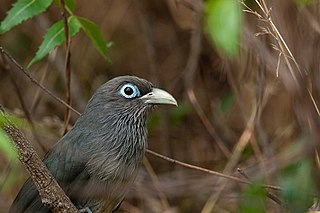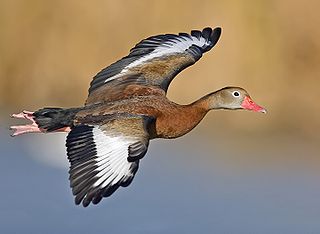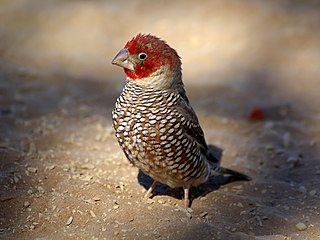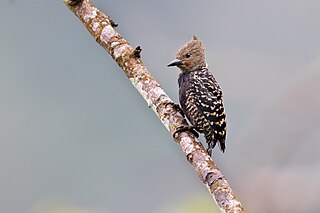
The blue-faced malkoha or small green-billed malkoha, is a non-parasitic cuckoo found in the scrub and deciduous forests of peninsular India and Sri Lanka. It has a waxy, dark, blue-grey plumage on its upperparts and has a long tail with graduated white-tipped feathers. The throat and chin are dark with spiny pale feathers that are branched. The lower belly is a dull creamy to rufous colour. The bill is apple green, and a naked patch of blue skin surrounds the eye. The sexes are alike. The blue-faced malkoha is a bird of open forests and scrub jungle.

The West Indian whistling duck is a whistling duck that breeds in the Caribbean. Alternative names are black-billed whistling duck and Cuban whistling duck.

The whistling ducks or tree ducks are a subfamily, Dendrocygninae, of the duck, goose and swan family of birds, Anatidae. In other taxonomic schemes, they are considered a separate family, Dendrocygnidae. Some taxonomists list only one genus, Dendrocygna, which contains eight living species, and one undescribed extinct species from Aitutaki of the Cook Islands, but other taxonomists also list the white-backed duck under the subfamily.

The black-bellied whistling duck, formerly called the black-bellied tree duck, is a whistling duck that before 2000 bred mainly in the southernmost United States, Mexico, and tropical Central to south-central South America. It can be found year-round in much of the United States. It has been recorded in every eastern state and adjacent Canadian province. Since it is one of only two whistling duck species native to North America, it is occasionally just known as the "whistling duck" or "Mexican squealer" in the southern USA.

The Namaqua dove is a small pigeon. It is the only species in the genus Oena. It is found over much of Sub-Saharan Africa as well as Arabia and Madagascar.

The stone partridge is a bird of the New World quail family. This largely brown bird, which commonly holds its tail raised, is found in scrubland and lightly wooded habitats, often near rocks, from Kenya and Ethiopia to Gambia.

Ptilopachus is an African genus of birds in the New World quail family.

The chestnut-bellied partridge also known as chestnut-bellied hill-partridge or Javan hill-partridge is a small, up to 28 cm long, partridge with a rufous crown and nape, red legs, grey breast, brown wings, red facial skin, and a black mask, throat and bill. It has a rufous belly with white on the middle. The sexes are similar. The young has a whitish face and a reddish brown bill.

The green-winged pytilia is a small colourful seed-eating bird in the family Estrildidae. It is widespread throughout Sub-Saharan Africa, though it is more rarely seen in central, far southern and coastal western parts of the continent.

The red-headed finch is a common species of estrildid finch found in Africa. It has an estimated global extent of occurrence of 1,600,000 km2. It is found in Angola, Botswana, Lesotho, Namibia, South Africa and Zimbabwe.

The red-throated parrotfinch is a species of estrildid finch found in New Caledonia. It has an estimated global extent of occurrence of 20,000 to 50,000 km2.

Geositta is a genus of passerine birds in the ovenbird family, Furnariidae. They are known as miners due to the tunnels they dig for nesting. There are 11 species including the campo miner which was formerly classified in a genus of its own, Geobates. They inhabit open country in South America, particularly the Andean and Patagonian regions. They are ground-dwelling birds, somewhat resembling the larks and wheatears of other continents. They are mostly drab brown in coloration and often have a fairly long and slender bill.

The Guianan red cotinga is a species of bird in the family Cotingidae, the cotingas. It is one of two species in the genus Phoenicircus.

Hemicircus is a genus of birds in the woodpecker family Picidae. Members of the genus are found in India and Southeast Asia.

Meiglyptes is a genus of Southeast Asian birds in the woodpecker family Picidae.

The zebra woodpecker is a species of bird in the family Picidae. It is found in Java. Its natural habitats are subtropical or tropical dry forests and subtropical or tropical moist lowland forests.

Pytilia is a genus of small brightly coloured seed-eating birds in the family Estrildidae. They are distributed across Africa.

Parrotfinches are small, colourful passerine birds belonging to the genus Erythrura in the family Estrildidae, the estrildid finches. They occur from South-east Asia to New Guinea, and many Pacific Islands. They inhabit forest, bamboo thickets and grassland and some can be found in man-made habitats such as farmland, parks and gardens. Several species are commonly kept as cagebirds.

The southern red bishop or red bishop is a small passerine bird belonging to the bishop and widowbird genus Euplectes in the weaver family, the Ploceidae. It is common in wetlands and grassland in Africa south of the Equator. North of the Equator, it is replaced by the northern red bishop or orange bishop which was formerly regarded as a subspecies of this species.

The brown cuckoo-dove is a dove in the genus Macropygia found in Australia from Weipa and Aurukun in the north to Bega in the south, and most inland at Atherton and Toowoomba. It is sometimes called the "brown pigeon" or "pheasant pigeon", but both terms are best avoided, as they can lead to confusion with the brown doves and the true pheasant pigeon. It was one of three new species defined when the slender-billed cuckoo-dove was split in 2016.






















